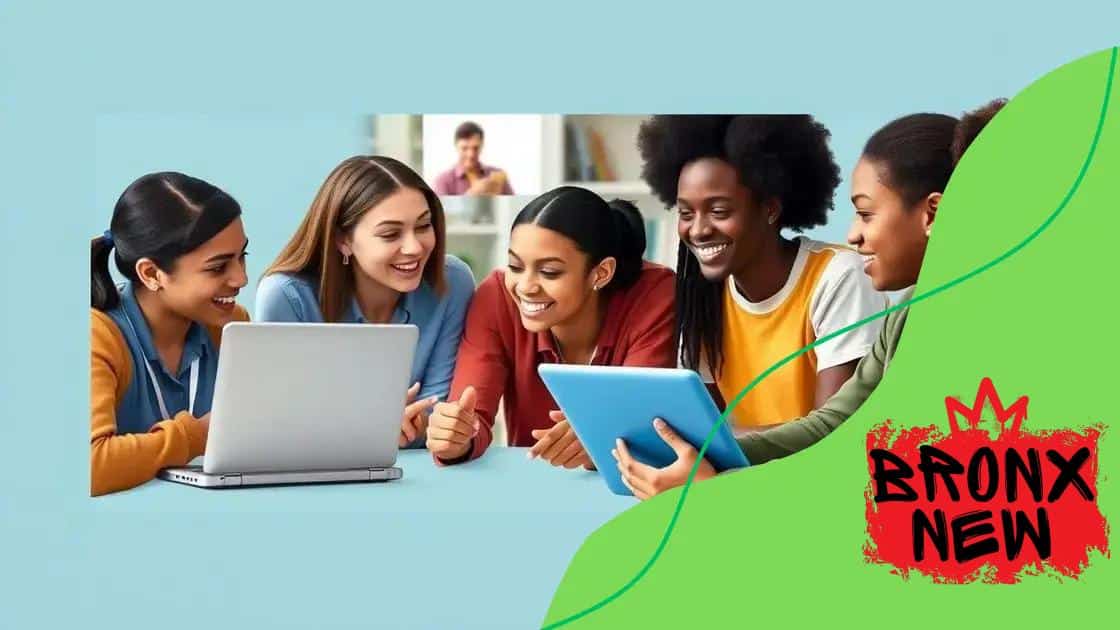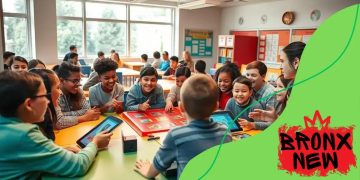Collaborative learning in virtual classrooms: enhance engagement

Collaborative learning in virtual classrooms enhances student engagement by fostering communication, utilizing interactive tools, and encouraging peer collaboration, making the learning experience dynamic and effective.
Collaborative learning in virtual classrooms is transforming education, enabling students to connect and grow together, even from a distance. Have you ever wondered how teamwork can thrive online? Let’s dive into how this approach can enhance your learning experience.
what is collaborative learning?
Collaborative learning is an educational approach where students work together to achieve a common goal. In this process, they share knowledge, resources, and skills to enhance their learning experience. The essence of collaborative learning lies in the idea that teamwork leads to deeper understanding and retention of information.
This method is particularly effective in virtual classrooms, where technology enables real-time communication and collaboration among students. By interacting with peers, learners can gain different perspectives, actively engage with the material, and develop critical thinking skills.
Key Features of Collaborative Learning
There are several important features that define collaborative learning:
- Group Work: Students often work in small groups, allowing them to share their thoughts openly.
- Active Participation: Each member actively contributes to discussions and projects, promoting responsibility and inclusion.
- Peer Feedback: Students give and receive feedback from each other, fostering a supportive learning environment.
Collaborative learning can take many forms, including group projects, discussions, and peer teaching. These activities not only make learning enjoyable but also help students develop important social skills.
Benefits of Collaborative Learning
There are numerous benefits tied to this engaging approach. For instance, teamwork boosts motivation and accountability among students. When learners rely on one another, they’re more likely to stay focused and committed to the task at hand.
Additionally, collaborative learning enhances problem-solving skills, as students often tackle challenges collectively. By collaborating, they learn to communicate effectively and think critically. This method also builds a sense of community, making participants feel more connected to their peers.
Overall, collaborative learning creates a dynamic and inclusive environment where students can thrive together, making it an essential component of modern education.
benefits of collaborative learning in virtual settings
Collaborative learning in virtual settings offers numerous advantages that enhance the educational experience. One major benefit is increased engagement. When students work together online, they become active participants in their learning. This fosters a sense of belonging, making them more invested in the outcomes.
Another significant advantage is the development of communication skills. Students learn to express their ideas clearly and listen to their peers. Through group discussions and projects, they practice articulating their thoughts, leading to greater confidence in their abilities.
Enhanced Learning Outcomes
Research has shown that students who engage in collaborative learning often achieve better academic results. They gain diverse perspectives, which deepens their understanding of the subject matter.
- Collaboration reinforces critical thinking by challenging students to defend their viewpoints.
- Working in teams helps improve problem-solving abilities.
- Group work allows learners to explore various approaches and solutions.
This method also encourages self-regulation. Students learn to set goals and manage their time effectively. They hold each other accountable, leading to improved personal responsibility. In a virtual setting, this accountability is vital, as it helps students navigate the challenges of online learning.
Furthermore, collaborative learning nurtures social connections. It creates opportunities for students to form friendships and build networks. These relationships are crucial in fostering a supportive learning environment, especially in a virtual space where students may feel isolated.
Ultimately, the benefits of collaborative learning in virtual settings extend beyond academics. They equip students with valuable life skills such as teamwork, adaptability, and communication, which are essential in today’s interconnected world.
effective tools for virtual collaboration

When it comes to virtual collaboration, having the right tools can significantly enhance the learning experience. Various platforms and applications enable students to work together seamlessly, regardless of their physical location. By utilizing these tools, learners can communicate, share resources, and collaborate on projects effectively.
Popular Tools for Virtual Collaboration
Several tools stand out for their effectiveness in fostering collaboration in virtual settings.
- Zoom: A video conferencing tool that allows real-time communication, making it easy for groups to meet and discuss projects.
- Trello: A project management application that helps teams organize tasks, set deadlines, and track progress visually.
- Google Workspace: A suite of tools including Docs, Sheets, and Drive, where students can work together on documents and share files easily.
- Slack: A messaging platform that facilitates communication among team members through channels and direct messages.
These tools enable students to collaborate more organically. For instance, Zoom allows for face-to-face interaction, which can mimic an in-person classroom environment. Such engagement is critical for building relationships and understanding complex topics better.
Features to Look For
When choosing tools for collaboration, consider the following features:
- User-Friendly Interface: Ensure the tool is easy to navigate for all students, minimizing barriers to participation.
- Real-Time Collaboration: Tools that allow multiple users to work simultaneously make collaboration more dynamic.
- Integration Capabilities: Select tools that integrate well with other applications, enhancing functionality and user experience.
The best tools support not just organization and management but also foster strong communication and teamwork. As students become comfortable using these platforms, they develop important skills that will serve them not only in school but also in their future careers.
Overall, implementing effective tools for virtual collaboration lays the foundation for successful group work, enabling students to thrive in an online learning environment.
strategies to enhance student engagement
Enhancing student engagement in virtual classrooms is crucial for effective learning. Various strategies can create a lively and interactive environment where students feel motivated to participate actively. One essential approach is the incorporation of interactive activities such as polls, quizzes, and breakout sessions, which encourage students to share their thoughts and ideas.
Another powerful strategy involves the use of multimedia resources. Incorporating videos, infographics, and other visual elements can grab students’ attention and make lessons more enjoyable. This not only supports different learning styles but also keeps the material fresh and exciting.
Fostering Collaboration
Collaboration plays a vital role in student engagement. Pairing students for group projects can help them build connections and learn from each other. When they support one another, they become more invested in the learning process. Techniques such as peer reviews and group discussions can help facilitate this collaborative culture.
- Encourage open communication: Create an atmosphere where students feel safe to express their thoughts.
- Utilize breakout rooms: Allow students to work in smaller groups during online sessions.
- Implement peer teaching: Have students teach concepts to each other.
Incorporating elements of gamification is another effective strategy. By adding game-like features, such as points, badges, or leaderboards, educators can increase motivation and competition among students. This fun approach not only stimulates interest but also promotes a sense of achievement.
Finally, regularly seeking student feedback is crucial. This can involve simple surveys or discussions about what they enjoy and what could be improved. When students see their opinions valued, they are more likely to engage actively in the learning process.
Ultimately, combining these strategies can create a rich and engaging virtual learning environment that keeps students motivated and excited about their education.
overcoming challenges in virtual learning
Overcoming challenges in virtual learning is crucial to ensure effective education. Many students face obstacles in a digital environment that can hinder their learning experience. Recognizing these challenges is the first step toward finding solutions. Common issues include technical difficulties, lack of motivation, and feelings of isolation.
Technical problems can disrupt lessons. Slow internet connections or software issues may prevent a seamless experience. To tackle this, it’s important to equip students with the necessary tools and resources. Providing access to reliable technology and support can help minimize these disruptions.
Maintaining Motivation
Another challenge in virtual learning is keeping students motivated. The absence of a traditional classroom setting may lead some learners to feel detached from their studies. To enhance motivation, educators can incorporate engaging activities that capture students’ attention. Interactive elements such as quizzes, discussions, and multimedia presentations can help make learning more exciting.
- Set clear goals: Help students understand what is expected of them and the importance of their participation.
- Utilize gamification: Introducing points or rewards can boost engagement and motivation.
- Provide regular feedback: Acknowledging student efforts can encourage them to stay committed.
Combatting isolation is also essential in a virtual setting. Many students miss the social interactions of a physical classroom, which can impact their emotional well-being. Creating opportunities for peer interactions through group projects or virtual meetups can help alleviate feelings of loneliness. Encouraging open communication among students helps build a sense of community, which is vital for morale.
In addition, it’s important for educators to be aware of their students’ mental health. Regular check-ins can help identify any issues they might be facing and provide the necessary support. Resources such as counseling services should be made available to assist those in need.
By addressing these challenges head-on, educators can foster a more effective and supportive virtual learning environment.
FAQ – Frequently Asked Questions about Collaborative Learning in Virtual Classrooms
What are the main challenges in virtual learning?
The main challenges include technical difficulties, lack of motivation, and feelings of isolation among students.
How can technology support virtual learning?
Technology can provide tools for communication, collaboration, and interactive learning experiences that enhance student engagement.
What strategies can educators use to keep students motivated?
Educators can use interactive activities, gamification, and regular feedback to maintain students’ motivation in a virtual setting.
Why is peer collaboration important in virtual classrooms?
Peer collaboration fosters a sense of community, enhances learning through shared ideas, and helps develop essential teamwork skills.





